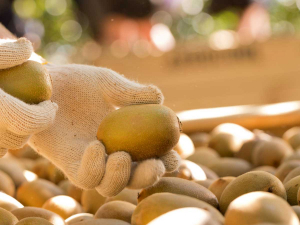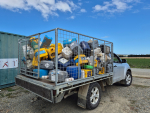Kiwifruit trader, Zespri says its European kiwifruit harvest is again expected to deliver strong returns for growers in Italy and France.
It is also forecasting “another great tasting crop” for consumers around the world to enjoy.
Sheila McCann-Morrison, Zespri’s chief international production officer, says that with the Northern Hemisphere harvest well underway, Zespri is expecting to harvest around 19 million trays or almost 70 tonnes of kiwifruit from orchards throughout Italy, France and Greece.
It’s been a tough season for some European growers this year, with a cold wet spring negatively affecting pollination and issues including the presence of the Brown Marmorated Stink Bug and Moira disease affecting kiwifruit and other local produce.
However, despite those challenges, this season’s Northern Hemisphere crop is still expected to be around the same as the record set last year.
“That’s going to mean we can again provide strong returns to the local industry which is something we’re very proud of,” she says.
"And more broadly, with this fruit being grown and picked by locals and packed in local post-harvest facilities, we're continuing to strengthen our relationships with the local industry and make a positive local impact,” McCann-Morrison says.
Zespri’s European growers – around 750 families - play a key role in Zespri’s global supply strategy which supplies premium Zespri Kiwifruit for all 12 months of the year. With growing global demand for premium kiwifruit, the relationships the business has formed over more than 20 years working with European growers are increasingly important.
“It’s a relationship that’s working incredibly well for both Italian growers, post-harvest operators and distributors, as well as for Zespri and the New Zealand industry,” McCann-Morrison says.
“It’s helping deliver greater orchard gate returns, jobs for locals and is also leading to tens of millions of Euros being invested in orchards and post-harvest facilities. It’s also helping foster further collaboration including technical exchange through R&D, grower workshops and nursery visits in New Zealand and other general support – all of which are helping boost production.”
Zespri is involved in a number of trials to help local growers overcome the threats posed by pests and disease.
“Brown Marmorated Stink Bug is having a huge impact on European crops including kiwifruit and so we’re working with locals to address this threat, as well as continuing to invest significantly with our partners on mitigating the impact of the vine-killing disease Psa,” she says.
“Our industry knows first-hand the risks associated with biosecurity and the significant costs associated with an incursion - if we can find ways to reduce the impact then the benefits will be immense.”
McCann-Morrison says market access is also a significant focus for Zespri.
“We’re committed to helping create access to new markets for European exporters as we have recently with Mexico so we’re ensuring an even greater number of consumers around the world can access our premium kiwifruit.
“Global supply, or Zespri Kiwifruit grown outside of New Zealand, is currently around 10% of all the fruit sold internationally by Zespri, but that will increase significantly along with demand.
“At the moment we have around 3,100 hectares in the ground in Europe and that’s set to grow to around 5,000 hectares over the next five years.”
McCann-Morrison confirmed all non-New Zealand-grown Kiwifruit must meet Zespri’s stringent quality standards, with quality managed through the Zespri System.
“Zespri’s purpose is to help communities around the world thrive through the goodness of kiwifruit.
“European growers are some of the best in the world and it’s great to be sharing our knowledge, systems and varieties with them, and also to be learning in return,” McCann-Morrison says.











